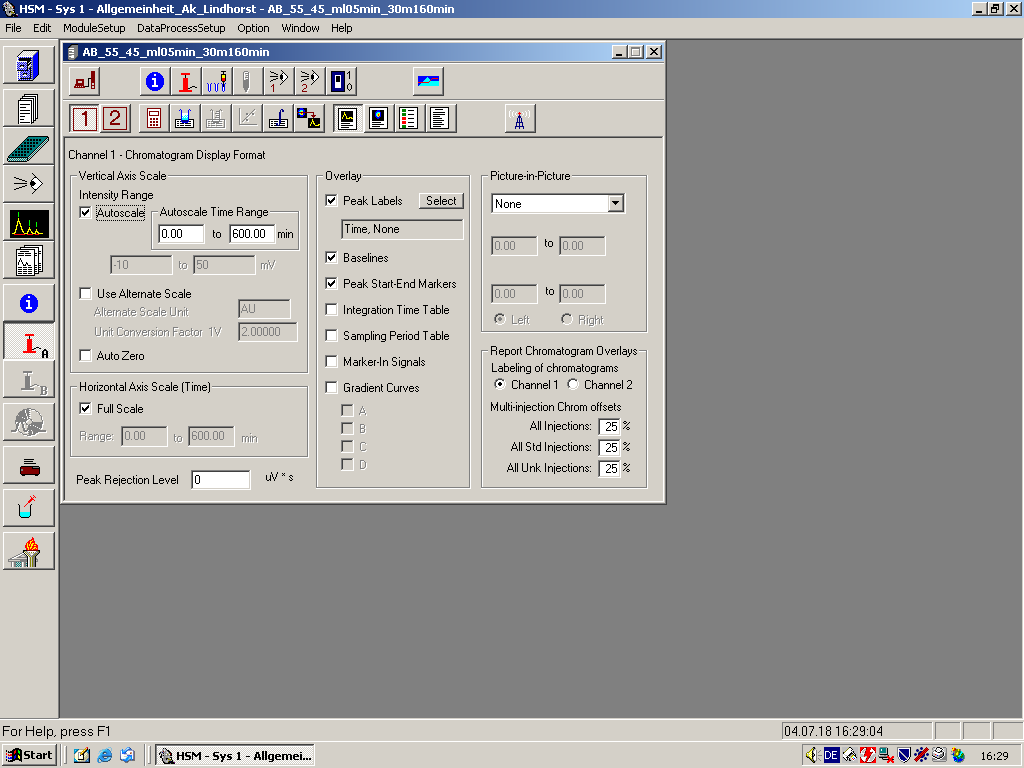Chromatogram Display Format
Use this command to specify how the chromatogram will be displayed on the Data Acquisition and Data Processing screens as well as in a report.
Tool Bar Shortcut
| Dialog Box | |
|---|---|
| Vertical Axis Scale | Intensity Range: Enter the absorbance range for the Chromatogram display. When the Autoscale box is checked, the Autoscale Time Range is enabled for you to specify and the absorbance range is disabled. Default time range is from 0.00 to 600.00 minutes. Then, the Vertical Axis Scale of the chromatogram is automatically adjusted so that the highest peak in the specified time range is fully displayed.
Use Alternate Scale: Select Alternate Scale Unit to use different scale units and enter the corresponding Unit Conversion Factor. The default for scale units is AU. The corresponding default for conversion factor is 2.0 AU/V. Note: When DAD is used, the default is 2.0 AU/V regardless of whether Normal or Low Absorbance is selected in DAD Setup. Auto Zero: Specifies that the chromatogram be shifted vertically so that the beginning of the chromatogram coincides with the zero position on the vertical scale. |
| Horizontal Axis Scale | Time Range: Enter a time range for the Chromatogram display. |
| Overlay | Baselines: Determines whether to display the baseline with the chromatogram. If selected, the overlaid baseline is displayed in a different color on the screen.
Peak Start-End Markers: Specifies markers be displayed to indicate the starting point and ending point of a peak. Marker-In Signals: Specifies that fraction markers be displayed. Peak Label: When selected, labels the peaks in a chromatogram using one of the following: Time, Name, Number, Area, or Height. Time Table: Specifies either Integration Time Table or Sampling Period Table, or both, for overlay display. Note that the noise function will not be displayed in the Integration Table overlay. Marker-In Signals: Check to overlay the marker-in signals sent from a fraction collector. Gradient Curves: Allows you to overlay the gradient curves of solvent composition for each solvent used in data acquisition. Gradient Curves is disabled if Gradient Mode is None in the Method Configuration. Selections of A, B, C or A, B are available for gradient mode of Low or High, respectively, for D-6000 Interface. Similarly, selections of A, B, C, D or A, B, C are available for gradient mode of Low or High, respectively, for the D-7000 Interface. |
| Picture-in-Picture | To display Chrom-in-Chrom, select Chrom-in-Chrom in the drop-down list and enter the Intensity Range (-4000 to 4000 mV, -8.0 to 8.0 AU) and Time Range (-300 to 900 min) in the edit boxes.
To display Spectra-in-Chrom, first open the Component Table and select SPECTRUM in one of the FUNC columns for desired component(s). Then, open select Spectr-in-Chrom in the drop-down list. If you did not select SPECTRUM in the FUNC column of the Component Table a warning message is displayed. |
| Peak Rejection Level | The value entered (Area or Height, depending on the peak quantitation option specified on Calculation Method screen) is used as a threshold to eliminate small peaks from the report. Peaks with area or height less than the value entered are not reported. The unit for Area is mV (sec) and the unit for Height is mV. |
| Report Chromatogram Overlays | Only activated when chromatograms are available on channels 1 and 2. Allows you to label either Channel 1 or Channel 2 on the overlay.
Multi-injection Chrom Offsets - You can set offsets differently in multi-injection chromatogram graphs in reports for All Injections, All Std Injections, or All Unk Injections. The offsets only apply to the channel currently set up for chromatogram display format. |
